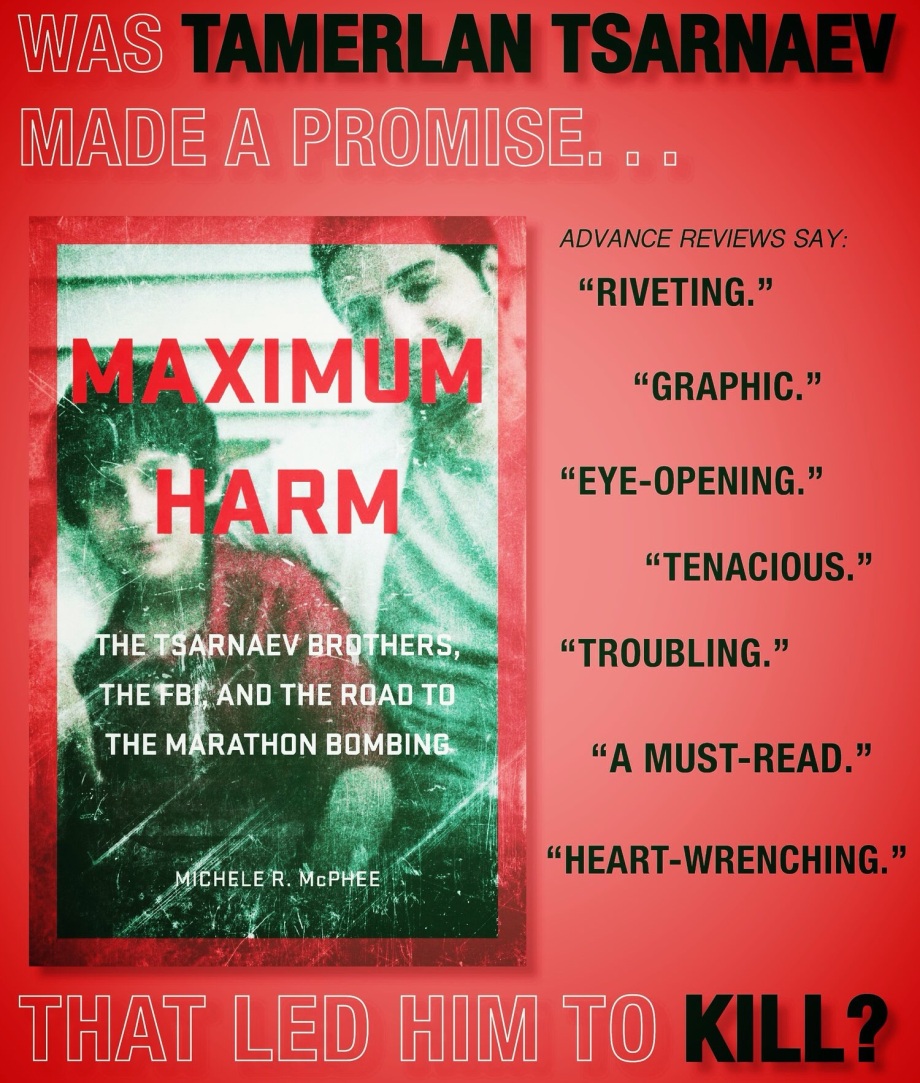
Maximum Harm: The Tsarnaev Brothers, The FBI, and the Road to the Marathon Bombing by Michele R. McPhee
Review by Rob Watts Follow @RobWattsOnline
Let me start off by saying that true-crime author and investigative reporter, Michele McPhee, deserves a great deal of credit for the tremendous amount of work put into writing the book, Maximum Harm. The exhaustive research along with the tedious process of fact-checking, conducting interviews, tracking down evidence reports, victim’s testimonies, medical reports, arrest records, so-on-and-so-forth—the leg work that she’s put into this book project is immeasurable and should not be overlooked. Why do I give praise to this fact so early on in my review? Frankly, as a life-long resident of Boston, I’m angered to this day over what had happened during Marathon Monday on April 15th, 2013. And like many, many residents who live in the Boston area (many whom’ve been directly affected by the bombing attacks), we’ve always been left with more questions than answers. Sure, the media reported the basics—they’d deliver information in dribs and drabs, but ultimately the deeper and darker story behind the story was somehow always shrouded in mystery. Maximum Harm finally delivers the facts in a very informative and eye-opening manner.
Upon reading the opening chapters, we are given a harsh and descriptive look at the mayhem that ensued during the critical moments following the two blasts. The grim details (and they are in-fact grim) of the victims who’d lost limbs, spectators who had gotten separated from their families and loved ones, the E.M.T.s who rushed in to tend to the countless victims within minutes amid the chaos, the efforts of local law enforcement, the Boston Fire Department, random civilians who had rushed to help the bloodied victims; knowing full-well that more explosions could in-fact detonate in their vicinity, the marathon volunteers—this in-depth vantage point is all laid out for the reader to get a sense of just how dire and uninviting this tragedy was and how the timeline unfolded from that point forward.
As I had mentioned, there have been so many unanswered and poorly explained answers up until now and thankfully, McPhee does a remarkable and impressive job at piecing the puzzle together. So what prompted the foreign-born brothers, Tamerlan, (born in Siberia in 1986) and Dzhokhar (born in Kyrgyzstan in 1993) to attack their country—who’d seemingly rolled out the red carpet for them and their family members, in such a horrific and monstrous manner? You would need to trace their family beginnings back to their war-torn homeland of Chechnya, their fleeing from Russia to finally settle into Cambridge, Massachusetts (upon which they received free housing and a bevy of government handouts and benefits), enrolling the Tsarnaev brothers in Cambridge Rindge and Latin, one the the finest public schools in America, and ultimately enrolling younger brother Dzhokhar into UMass Dartmouth. If you’re saying to yourself, Gee, this doesn’t sound like a recipe for disaster, then you’d normally be correct. Many factors along the way played into what would become Boston’s darkest days. A handful of those factors were:
- The Tsarnaev family had been granted political asylum. Younger brother, Dzhokhar had become an American citizen; this was something elder brother Tamerlan wanted so desperately, yet he was denied.
- The denial of U.S. citizenship resulted in Tamerlan being denied a place on the United States Olympic Team as a boxer, a sport in which he was passionate about and had trained incessantly over.
- The FBI, who had employed Tamerlan as an informant, apparently broke their promise to grant him citizenship if he cooperated with them.
- Tamerlan’s eventual radicalization and the influence he had on younger brother, Dzhokhar.
McPhee also sheds light on a number of questions, such as
- Without a valid passport and while being on TWO terror watch lists, how was Tamerlan free to travel to and from Russia and The United States without any red flags?
- Why did the FBI and CIA ignore repeated warnings about Tamerlan from the Russian Federal Security Service?
- Were Tamerlan and Dzhokhar directly involved in the triple homicide of Erik Weissman, Raphael Teken, and Brendan Mess on Sept 11th, 2011?
- How was it that Tamerlan could afford to drive a lavish vehicle and own expensive clothing without ever having worked a job?
- What is Tamerlan’s uncle, Ruslan Tsarni’s connection to the CIA?
- Did the FBI know who the suspects were prior to their acknowledgment, and if so, would MIT Officer Sean Collier still be alive today?
- If the Feds hadn’t ignored these repeated red flags and warnings, might Krystie Campbell (aged 29), Lü Lingzi (aged 23) and Martin Richard (aged 8) still be alive today?
There is a lot of information to absorb from this book, but it flows at a consistent and rapid pace. Although this book may have more regional appeal to those living in and around the Massachusetts area, I would urge everyone to pick this up and give it a read. It’s important to know what’s going on behind the scenes of law enforcement—be it shady dealings or beneficial practices, and it’s vital to ask questions (at least to yourself) about how these dubious affairs affect our daily lives and jeopardize our safety.
Pick up a copy of Maximum Harm available at Amazon.com
